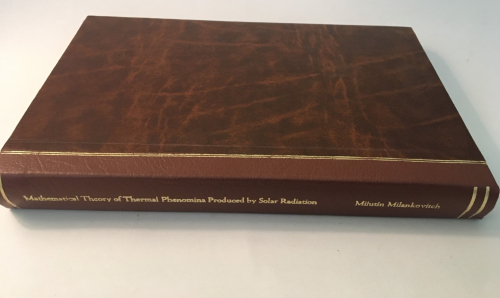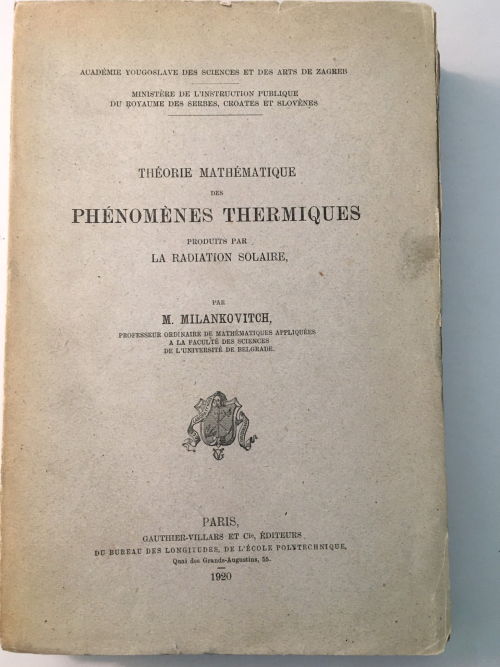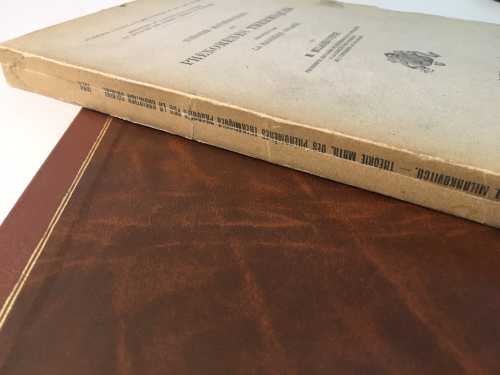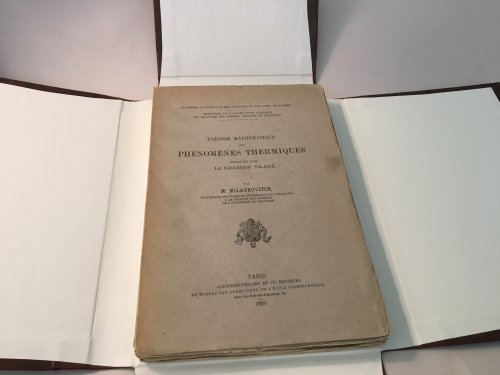Milutin Milankovitch. Théorie mathématique des phénomènes thermiques produits par la radiation solaire. (Mathematical theory of thermic phenomena caused by solar radiations.) SOLD
Paris, Gauthier-Villaras, 1920. 9.5x 6.5”; xii, 338, (1)pp.
Classic Gauthier -Villars publication, which is too big and heavy for the perfect binding—this volume has a slight crack in the spine middle from having been read (or opened many times). There is also a thin piece of rear cover missing at edge (about 1/4”x 2”). That said, still a near-Fine copy.
Housed in a custom pamphlet case (of similar materials as the custom box housing the 1941 document, made by the same bookbinder), which is in as-new condition.
“Milankovitch revolutionized the understanding of climate dynamics. He put the astronomical theory of climate on a firm mathematical basis and founded cosmic climatology by calculating the temperature conditions on planets of the inner solar system, and the depth of the atmosphere of the outer planets. In particular he calculated the impact of Earth’s secular orbital cycles on climate changes and explained the origin of the Pleistocene ice ages. The perennial periodic orbital variations (eccentricity, obliquity, precession) considered in his canon of insolation, along with their influence on planets’ climates, today are called Milankovitch cycles.”
“(In this work) he resolved the problem of thermodynamics of inner planets of the solar system and attained the first reliable predictions about the present climates of Mercury, Venus, Mars, and the Moon, generally still valid, with the exception of Venus. After 1920, when cooperation with Wladimir Köppen and Alfred Wegener began, Milankovitch turned his attention exclusively to Earth’s climate, specifically the problem of ice ages. His primary focus was the insolation of Earth in the last six hundred thousand years at middle latitudes. The best-known result of the work was the “Curve of Insolation,” first published in 1924, in Köppen and Wegener’s book Die Klimate der geologischen Vorzeit. Being coincident with contemporary dating of four Alpine glacial periods, determined fifteen years earlier by Albrecht Penck and Eduard Brückner, the curve soon became widely accepted as a geological calendar for calibrating the paleoclimatological timescale.”--Complete Dictionary of Scientific Biography online
"He formulated a precise, numerical climatological model with the capacity for reconstruction of the past and prediction of the future, and established the astronomical theory of climate as a generalized mathematical theory of insolation. When these most important problems of the theory were solved, and a firm foundation for further work built, Milanković finished a book which was published in 1920, by the Gauthier-Villars in Paris under the title "Théorie mathématique des phénomènes thermiques produits par la radiation solaire" (Mathematical Theory of Heat Phenomena Produced by Solar Radiation). Immediately after the publication of this book in 1920, meteorologists recognized it as a significant contribution to the study of contemporary climate."--Milankovitch wikipedia entry
“When Milankovitch received printed copies of his book from his Paris publisher, he sent one sample to Vladimir Köppen. Köppen (“...a principal founder of modern meteorology and climatology”-DSB) was so impressed by Milankoviitch's introduction of advanced mathematics into Earth sciences that he immediately wrote him a postcard, stating, “I am impressed by the abundance of reason and clarity in your interpretation, and I am truly grateful for this precious gift...” (Köppen's letter to Milankovitch) 1921; Milankovitch 1997, 474).
“The father of paleoclimates”--Berger, “Milankovitch, pere de la theorie astronomiques des paleoclimats”, Theorie et Mesure, 1988, p 385.
- There are two interesting review of this work in English published in 1923: Bulletin of the AMS by PJ Daniel, August 1923; and Nature 112, August 1923, pp 160-161.









Comments